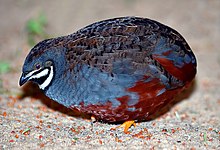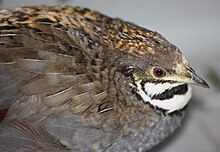King quail
| King quail | |
|---|---|

| |
| Scientific classification | |
| Domain: | Eukaryota |
| Kingdom: | Animalia |
| Phylum: | Chordata |
| Class: | Aves |
| Order: | Galliformes |
| Family: | Phasianidae |
| Genus: | Synoicus |
| Species: | S. chinensis
|
| Binomial name | |
| Synoicus chinensis (Linnaeus, 1766)
| |
| Synonyms | |
| |


The king quail (Synoicus chinensis), also known as the blue-breasted quail, Asian blue quail, Chinese painted quail, or Chung-Chi, is a species of
Description
Male king quail occur in many colors, including blue, brown, silver, maroon, dark brown, and almost black. They have orange feet that are hard and able to withstand a continuous life on the ground like many other
Taxonomy
Six subspecies are recognized:[2]
- S. c. chinensis (Linnaeus, 1766): Found from India and Sri Lanka to Malaya, Indochina, southeastern China, and Taiwan
- S. c. trinkutensis Richmond, 1902: Nicobar blue-breasted quail, found on the Nicobar Islands
- S. c. lineatus (Sula Islands
- S. c. lepidus (Hartlaub, 1879): Found in New Guinea and the Bismarck Archipelago
- S. c. victoriae (Mathews, 1912): Found in eastern Australia
- S. c. colletti (Mathews, 1912): Found in northern Australia
The species has had a complex taxonomic history, being classified into the genus Coturnix, then Synoicus, then Excalfactoria. Phylogenetic evidence supports it belonging in an expanded Synoicus that, alongside the blue quail (S. adansonii) also includes the Snow Mountain quail (S. monorthonyx) and brown quail (S. ypsilophorus).[3][4]
The subspecies S. c. victoriae was formerly named C. s. australis (Gould, 1865), but the reclassification of the species into Synoicus caused this designation to be preoccupied by the Australian subspecies of the brown quail (S. y. australis), leading to the epithet being changed to victoriae (Mathews, 1912).[2]
Reproduction

| ) |
The males fight for the right to mate with the females. The winner then breeds every female. Females can then develop and lay an egg within one to two days of being bred. They either build a nest first or lay eggs on the ground. Females usually only go broody when they have collected an ideal clutch size. Clutch size varies from five to 13 eggs. Before incubation starts, all the eggs composing the clutch will have been laid. In captivity, the ideal number of eggs in a clutch is six to eight. The chicks hatch after about 16 days.
Conservation status
Australia
King quail are not listed as threatened on the Australian Environment Protection and Biodiversity Conservation Act 1999.
State of Victoria, Australia
This species is listed as threatened on the Victorian
On the 2007 advisory list of threatened vertebrate fauna in Victoria, this species is listed as
Aviculture
This quail has been very popular to keep and breed for many years; numerous
They may be housed in pairs to quartets in a planted aviary, kept singly in bird cages, or in colonies in large flights. Males may compete, as may females. Suspension cages do not work well for this species of quail because of their smaller feet; a much finer size of floor wire should be employed.[9]
Females lay an egg a day if kept on the proper diet. Nesting sites can be as spartan as a quiet corner or a depression in the ground against a wall. Preferably, a clump of long grass, tea tree branches, or pile of loose herbage should be provided. Often, a hen lays eggs on the aviary floor without the use of a nest. This is a sign that the birds are not content with the existing facilities and the provision of a sheltered nest site may result in a nest being built. The cock usually selects the nest site.[10] The nest is a simple scrape in the ground, lined with grasses, and is built by the hen with some assistance from the cock. The eggs measuring 25 x 19mm are variable in colour from the palest of browns to dark olive and peppered with fine black spots. Clutch size varies from four to 13, but occasionally a hen can be found incubating upwards of 20 eggs. It is usually a combined clutch from a number of hens, and due to the difficulties of turning and covering a clutch of that size, hatching rate is often poor. Removing some of the eggs and artificially incubating or fostering them may be beneficial.[10]
The species usually breeds year-round; incubation times are from 18 to 23 days before chicks hatch. The hen cares for the chicks until around 4 weeks of age, when they should be separated from parent birds into a separate aviary.
Hybrids and mutations
Hybrids of king quail and brown quail are known.
Silvers and cinnamon are the most common colour varieties.
Occasionally, cock-feathered hens appear; this is not a mutation as such, but one of a few conditions that affect normal
Diet
In the wild, the diet of king quail consists of small bugs, seeds, and various grasses that are available at the time. In aviculture, all birds should be fed a variety of seeds and a healthy range of fruit and vegetables. During breeding, hens should be fed calcium-rich food sources such as shell grit to prevent egg binding. Newly hatched chicks should be fed high-protein chick crumb mixed with a little water. Other sources of protein include mealworms and various insects.
References
- . Retrieved 12 November 2021.
- ^ a b "Pheasants, partridges, francolins – IOC World Bird List". www.worldbirdnames.org. Retrieved 2023-01-28.
- PMID 21716735.
- PMID 19636374.
- ^ Department of Sustainability and Environment, Victoria Archived 2005-07-18 at the Wayback Machine
- ^ Department of Sustainability and Environment, Victoria Archived 2006-09-11 at the Wayback Machine
- ISBN 978-1-74208-039-0.
- ^ Don Harper, Pet Birds for the Home & Garden; Salamander Press
- ^ a b JJ Holland, Observations of Quail, 2013
- ^ a b A Guide to Pigeons, Doves & Quail, 1995. Danny Brown B.Sc. (Hons)

